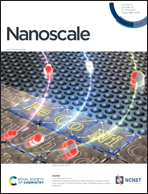Electrically tunable polarized luminescence from guest–host composites via interaction between rare earth complexes and liquid crystals†
Abstract
Polarized luminescence has many applications in energy saving, displays, communication and other fields. Here, electrically tunable polarized luminescence of aligned Eu(tta)3phen/E7 composites is successfully obtained based on the interaction between liquid crystal (LC) hosts and rare earth (RE) complex guests. The generation mechanism of the polarization effect is thoroughly explored from three different aspects. The polarized luminescence of Eu(tta)3phen/E7 composites is closely related to the polarized energy absorption of incident light, the site symmetry of Eu3+ ions for oriented Eu(tta)3phen complex molecules, and the polarized energy transfer from E7 to Eu(tta)3phen. The convenient control of the well-aligned Eu(tta)3phen complex by simply embedding the Eu(III) complex guest in the E7 host and utilizing small-magnitude electric field forces is explicitly confirmed. The E7 host not only provides the orientation condition for the electrically tunable polarized luminescence but also promotes the degree of polarization through polarized energy transfer. The polarized spectral properties and the symmetry of the Eu3+ site of the aligned Eu(tta)3phen complexes are described in detail. The analysis of the generation mechanism of polarized luminescence supplements the research content in the field of RE/LC composites and paves the way for exciting novel advances in the field of polarized emission.



 Please wait while we load your content...
Please wait while we load your content...